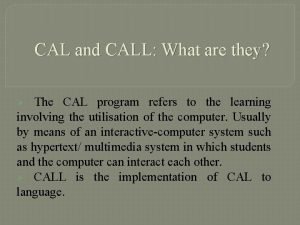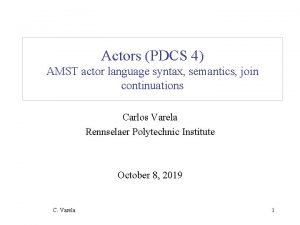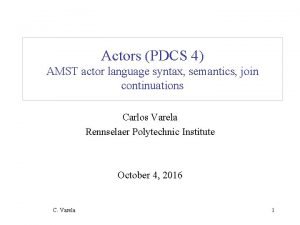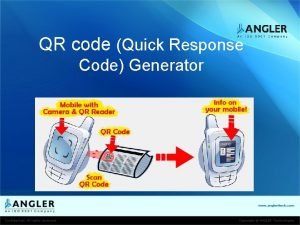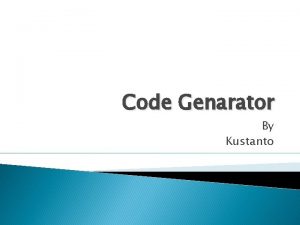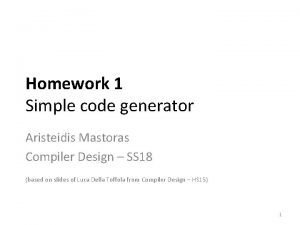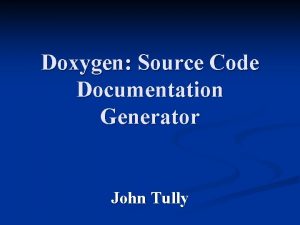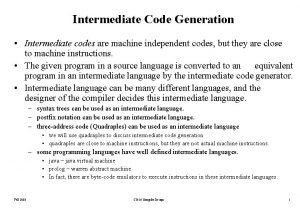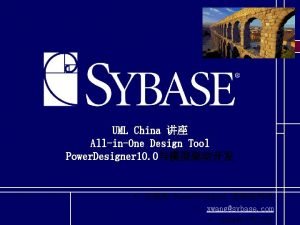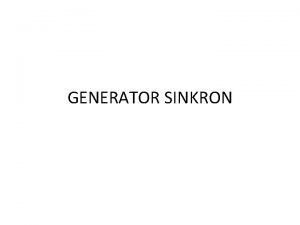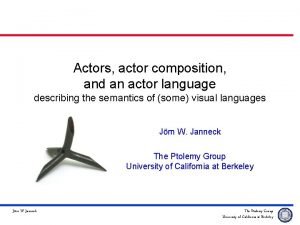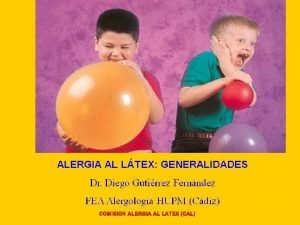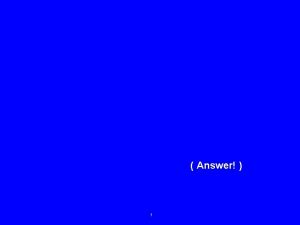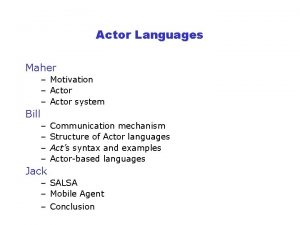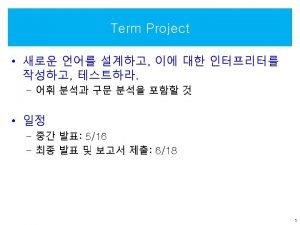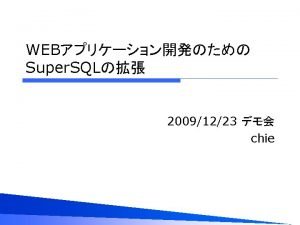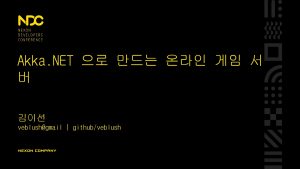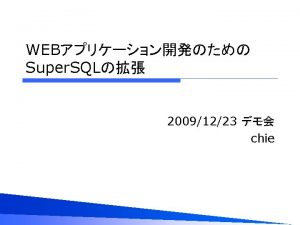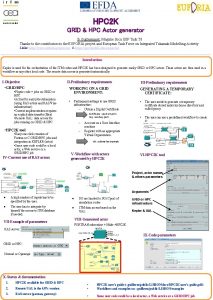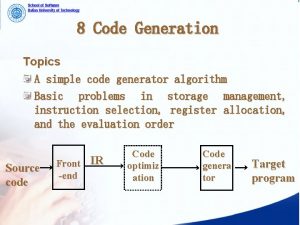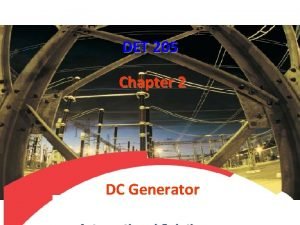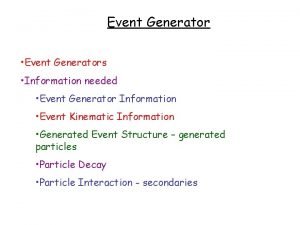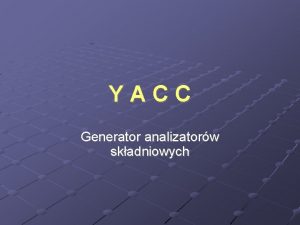A code generator for the CAL actor language













































- Slides: 45

A code generator for the CAL actor language Lars Wernli Supervisor: Joern Janneck, UC Berkeley Professor: Lothar Thiele, ETH Zuerich

What is Ptolemy II? continuous time finite-state machine discrete time Hierarchical, heterogeneous model

Actor oriented design parameters input ports 1 3 ‘A’ ‘C’ 12 ‘’ N Data output ports 42 Actor FIRE tokens ‘L’ 99 state 42 41 tokens ‘P’ Actors decouple data and control

Actor oriented design parameters input ports 1 99 12 ‘’ 45 2 N Actor token Data output ports state 45 42 4 41 tokens ‘P’ ‘L’ ‘A’ ‘C’ Actors decouple data and control

Actors in Ptolemy II Firing is divided into three phases: • prefire() 1 time – checks whether action can fire or not • fire() n times – calculates output tokens • postfire() 0 or 1 times – updates persistent state

Writing a Ptolemy actor int sum = 0, _sum; prefire() { return N. has. Token(); } fire() { _sum = sum; int n = N. get. Token(); if (Data. has. Tokens(n)) { _sum = _sum + n; for (int i = 0; i < n; i++) Out 2. put. Token(Data. get. Token()); Out 1. put. Token(_sum); } else { // what to do with the value of n? } } postfire() { sum = _sum; }

Writing a Ptolemy actor int sum = 0, _sum; prefire() { return N. has. Token(); } fire() { _sum = sum; int n = N. get. Token(); if (Data. has. Tokens(n)) { _sum = _sum + n; for (int i = 0; i < n; i++) Out 2. put. Token(Data. get. Token()); Out 1. put. Token(_sum); } else { // what to do with the value of n? } } postfire() { sum = _sum; }

What is CAL? CAL is a textual language for writing dataflow actors. The actor just introduced written in CAL: Integer sum : = 0; action N: [n], Data: [d] repeat n ==> Out 1: [sum], Out 2: [d] repeat n do sum : = sum + n; end

Motivation for using CAL • • makes writing actors more accessible reduces amount of code to be written reduces error probability allows information extraction for model analysis • CAL actors may be reused by other platforms, or new versions of Ptolemy

Design goal for CAL is intended to be retargeted to a variety of platforms • make retargeting as simple as possible – modular compiler design – modular code generation

CAL compilation —the big picture. parsing CAL source text Caltrop AST target platform transformation, annotation code generation CAL(0) CAL(1) Java platforms CAL(n) Cal. Core Pålsjö/Koala Leg. OS Ptolemy II Moses JGraf. Chart

Generic and specific actor Cal. Core platform specific code generator generic code generator • Code generator is easy to retarget • Actor core can be reused by other platforms

Code generator and target code design • Design goals 1. Make retargeting the code generator as simple as possible 2. Reusability of generated code 3. Optimize for speed 1. Challenges 1. specify an interface for generic part of the actor 2. matching the generic actor interface to Ptolemy API

State shadowing • Problem: state changing firing in CAL vs state-invariant fire() in Ptolemy mark. As. Changed(this) fire() { listener. rollback. All(); … } postfire() { … listener. commit. All(); } change listener generic variable interface assign(45) Ptolemy specific variable object State: 42 Shadow State: 45

State shadowing • Problem: state changing firing in CAL vs state-invariant fire() in Ptolemy rollback. All() fire() { listener. rollback. All(); … } postfire() { … listener. commit. All(); } rollback() change listener generic variable interface Ptolemy specific variable object State: 42 Shadow State: 45

State shadowing • Problem: state changing firing in CAL vs state-invariant fire() in Ptolemy mark. As. Changed(this) fire() { listener. rollback. All(); … } postfire() { … listener. commit. All(); } change listener generic variable interface assign(47) Ptolemy specific variable object State: 42 Shadow State: 47

State shadowing • Problem: state changing firing in CAL vs state-invariant fire() in Ptolemy fire() { listener. rollback. All(); … } postfire() { … listener. commit. All(); } change listener generic variable interface Ptolemy specific variable object State: 42 Shadow State: 47

State shadowing • Problem: state changing firing in CAL vs state-invariant fire() in Ptolemy commit. All() fire() { listener. rollback. All(); … } postfire() { … listener. commit. All(); } change listener commit() generic variable interface Ptolemy specific variable object State: 47 42 Shadow State: 47

State shadowing • Problem: state changing firing in CAL vs state-invariant fire() in Ptolemy fire() { listener. rollback. All(); … } postfire() { … listener. commit. All(); } change listener generic variable interface Ptolemy specific variable object State: 42 47 Shadow State:

Achievements • code generation for full-fledged language - higher-order function closures procedural closures set/list/map comprehensions input port patterns regular action selectors … • reusability of generated code • code generator easy to retarget to other Java platforms

Achievements • generated actors run with acceptable speed • facilitate retargeting to other languages (such as C) – design template for code generators • Pålsjö/Koala LTH – reusable infrastructure

Future work – Implement type checking – Describe the transformations on the AST in XML – Retarget the code generator to other platforms (Leg. OS UCB, Moses ETH? ) – Model compilation using CAL actor • Network + actors schedule • Network + actors + schedule actor

It’s time for a demo

Atomic actors in Ptolemy • • • implemented in Java domain polymorph ports parameters split-phase-firing: – prefire() – postfire()

Atomic actors in Ptolemy • • • implemented in Java domain polymorph ports parameters split-phase-firing: – prefire() – postfire()

The Ptolemy II GUI

Models in Ptolemy II • actor based • heterogeneous systems • hierarchical • composite actors treated like atomic • directors decouple behavior & control flow

Writing Ptolemy actors in Java. . • . . requires certain knowledge about the Ptolemy II API • . . results in platform specific classes • . . is error-prone • . . is often redundant • . . makes it hard to extract information from the actors Specifying actors in Java is problematic

Writing Ptolemy actors in Java. . • . . requires certain knowledge about the Ptolemy II API • . . results in platform specific classes • . . is error-prone • . . is often redundant • . . makes it hard to extract information from the actors Specifying actors in Java is problematic

A better approach We should be able to generate actors from a more abstract description. • Benefits: – makes writing actors more accessible – actors may be retargeted to other platforms, or new versions of Ptolemy – reduces error probability – reduces amount of code to be written – actors get more readable and analyzable

Can you guess what this does? actor B () Double Input ==> Double Output: Integer n : = 0; Double sum : = 0; action [a] ==> [sum / n] DO n : = n + 1; sum : = sum + a; end

Can you guess what this does? actor B () Double Input ==> Double Output: Integer n : = 0; Double sum : = 0; action [a] ==> [sum / n] : n : = n + 1; sum : = sum + a; end

What about this? actor Prime. Sieve () Integer Input ==> Integer Output: [Integer --> Boolean] filter : = lambda (Integer a) --> Boolean : false end; function divides (Integer a, Integer b) --> Boolean : b mod a = 0 end action [a] ==> [] guard filter(a) end action [a] ==> [a] guard not filter(a) var [Integer --> Boolean] f = filter do filter : = lambda(Integer b) --> Boolean: f(b) or divides(a, b) end; end

Actor. Core vs Ptolemy API • state management – fire vs firen/postfire – state changing computation vs state-invariant fire • input ports – random access to input channels vs sequential read methods

The runtime environment 1. Variable objects & change listener – – Support state shadowing Provide a generic interface to the Ptolemy Token and Parameter objects 2. Port wrappers – – Emulate random access input ports Provide a generic interface to the Ptolemy Typed. IOPorts Factory – – Creates wrapping objects facilitates decoupling between Actor. Core and Ptolemy API

Three implementation details • Actors at runtime 1. How the Pt. Actor passes Ptolemy objects to the Actor. Core via factory 2. How CAL scopes are represented in the Actor. Core • The code generator 3. How the code generator uses the visitor pattern to traverse the AST

1. Actors and the Factory

2. CAL scopes actor Deadlock. Prime. Sieve () Integer Input ==> Integer Output: [Integer --> Boolean] filter : = lambda (Integer a) --> Boolean : false end; action [a] ==> [a] guard not filter(a) var [Integer --> Boolean] f = filter do filter : = lambda(Integer b) --> Boolean: f(b) or (lambda (Integer a, Integer b)--> Boolean : b mod a = 0; end)(a, b) end end

2. Structure of the Actor. Core

3. The visitor pattern e. arg. Tuple. accept(this); // generate some code … e. function. accept(this); // generate more code … accept(this) visitor. visit. Application(this); visitor. visit. Tuple(this); visit. Application(this)

Problems solved • matching CAL to Ptolemy – single atomic action vs prefire/firen/postfire – state changing computation vs state-invariant fire – Cal. Core scopes vs Java scopes – random access to channels vs sequential read methods

Further work – Implement type checking – Describe the transformations on the AST in XML – Network + actors schedule – Network + actors + schedule actor – Retarget the code generator to other platforms (Moses ETH)

continuous time finite-state machine discrete time Hierarchical, heterogeneous model

Generic and specific code generator

The CAL compiler
 Cal and cal
Cal and cal Language
Language Amst actor language
Amst actor language Busceral
Busceral Human design famous reflectors
Human design famous reflectors Giant qr code generator
Giant qr code generator How to get immobilizer brake code
How to get immobilizer brake code Code generator adalah
Code generator adalah A simple code generator
A simple code generator Code documentation generator
Code documentation generator Intermediate code generation in compiler design
Intermediate code generation in compiler design Powerdesigner uml
Powerdesigner uml Bliqr
Bliqr Fspos
Fspos Novell typiska drag
Novell typiska drag Tack för att ni lyssnade bild
Tack för att ni lyssnade bild Vad står k.r.å.k.a.n för
Vad står k.r.å.k.a.n för Shingelfrisyren
Shingelfrisyren En lathund för arbete med kontinuitetshantering
En lathund för arbete med kontinuitetshantering Underlag för särskild löneskatt på pensionskostnader
Underlag för särskild löneskatt på pensionskostnader Tidbok för yrkesförare
Tidbok för yrkesförare Anatomi organ reproduksi
Anatomi organ reproduksi Densitet vatten
Densitet vatten Datorkunskap för nybörjare
Datorkunskap för nybörjare Stig kerman
Stig kerman Att skriva debattartikel
Att skriva debattartikel Autokratiskt ledarskap
Autokratiskt ledarskap Nyckelkompetenser för livslångt lärande
Nyckelkompetenser för livslångt lärande Påbyggnader för flakfordon
Påbyggnader för flakfordon Lufttryck formel
Lufttryck formel Offentlig förvaltning
Offentlig förvaltning Jag har nigit för nymånens skära text
Jag har nigit för nymånens skära text Presentera för publik crossboss
Presentera för publik crossboss Jiddisch
Jiddisch Plats för toran ark
Plats för toran ark Treserva lathund
Treserva lathund Fimbrietratt
Fimbrietratt Bästa kameran för astrofoto
Bästa kameran för astrofoto Cks
Cks Lågenergihus nyproduktion
Lågenergihus nyproduktion Mat för unga idrottare
Mat för unga idrottare Verktyg för automatisering av utbetalningar
Verktyg för automatisering av utbetalningar Rutin för avvikelsehantering
Rutin för avvikelsehantering Smärtskolan kunskap för livet
Smärtskolan kunskap för livet Ministerstyre för och nackdelar
Ministerstyre för och nackdelar Tack för att ni har lyssnat
Tack för att ni har lyssnat
